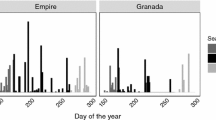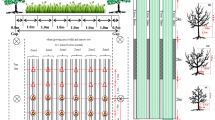Abstract
Light competition by trees is often regarded as a major limiting factor for crops in alley-crop** agroforestry. Northern latitude farmers are usually reluctant to adopt agroforestry as they fear that light competition will be fiercer in their conditions. We questioned the light availability for crops in alley-crop** at different latitudes from the tropic circle to the polar circle with a process-based 3D model of alley-crop** agroforestry. Two tree densities and two tree line orientations were considered. The effect of the latitude was evaluated with same-sized trees. The relative irradiance of the crops was computed for the whole year or at specific times of the year when crops need more light. The heterogeneity of crop irradiance across the alley was also computed. Surprisingly, crop relative irradiance of summer crops at high latitudes is high, at odds with farmers’ fears. Best designs were highlighted for improving the crop irradiance: North–South tree lines are recommended at high latitudes and East–West tree lines at low latitudes. At medium latitudes, North–South tree lines should be preferred to achieve an homogeneous irradiance of the crop in the alley. If we assume that trees at northern latitudes grow slower when compared to southern latitudes, then alley-crop** agroforestry is highly advisable even at high latitudes with summer crops.







Similar content being viewed by others
References
Abbate PE, Andrade FH, Culot JP, Bindraban PS (1997) Grain yield in wheat: effects of radiation during spike growth period. Field Crops Res 54(2–3):245–257
Bonhomme R (1993) The solar radiation: characterization and distribution in the canopy. In: Varlet-Granchet C, Bonhomme R, Sinoquet H (eds) Crop structure and Light Microclimate. INRA, Paris, pp 17–28
Calfapietra C, Gielen B, Karnosky D, Ceulemans R, Scarascia Mugnozza G (2010) Response and potential of agroforestry crops under global change. Environ Pollut 158(4):1095–1104
Cardinael R, Chevallier T, Barthès BG, Saby NPA, Parent T, Dupraz C, Bernoux M, Chenu C (2015a) Impact of alley crop** agroforestry on stocks, forms and spatial distribution of soil organic carbon. A case study in a Mediterranean context. Geoderma 259–260:288–299
Cardinael R, Mao Z, Prieto I, Stokes A, Dupraz C, Kim J, Jourdan C (2015b) Competition with winter crops induces deeper rooting of walnut trees in a Mediterranean alley crop** agroforestry system. Plant Soil 391(1):219–235
Chirko CP, Gold MA, Nguyen PV, Jiang JP (1996a) Influence of direction and distance from trees on wheat yield and photosynthetic photon flux density in a Paulownia and wheat intercrop** system. For Ecol Manag 83(3):171–180
Chirko CP, Gold MA, Nguyen PV, Jiang JP (1996b) Influence of orientation on wheat yield and photosynthetic photon flux density at the tree and crop interface in a Paulownia–wheat intercrop** system. For Ecol Manag 89(1–3):149–156
Connor DJ, Centeno A, Gomez-del-Campo M (2009) Yield determination in olive hedgerow orchards. II. Analysis of radiation and fruiting profiles. Crop Pasture Sci 60:443–452
Connor DJ, Gómez-del-Campo M, Trentacoste ER (2016) Relationships between olive yield components and simulated irradiance within hedgerows of various row orientations and spacings. Sci Hortic 198:12–20
Dauzat J, Eroy MN (1997) Simulating light regime and intercrop yields in coconut based farming systems. Eur J Agron 7(1–3):63–74
de Andrade CMS, Valentim JF, Carneiro JD, Vaz FA (2004) Growth of tropical forage grasses and legumes under shade. Pesqui Agropecu Bras 39:263–270
Demotes-Mainard S, Jeuffroy M (2004) Effects of nitrogen and radiation on dry matter and nitrogen accumulation in the spike of winter wheat. Field Crops Res 87(2–3):221–233
Dufour L, Metay A, Talbot G, Dupraz C (2013) Assessing light competition for cereal production in temperate agroforestry systems using experimentation and crop modelling. J Agron Crop Sci 199(3):217–227
Dufour-Kowalski S, Courbaud B, Dreyfus P, Meredieu C, de Coligny F (2012) Capsis: an open software framework and community for forest growth modelling. Ann For Sci 69:221–233
Dupraz C (1998) Adequate design of control treatments in long term agroforestry experiments with multiple objectives. Agrofor Syst 43(1–3):35–48
Dupraz C (2005) From silvopastoral to silvoarable systems in Europe: sharing concepts, unifying policies. In: Mosquera-Losada R, Riguerio A, McAdam J (eds) Silvopastoralism and sustainable land management. CAB International, Wallingford, pp 376–379
Dupraz C (2013) Adaptation of plurispecific systems to climate change. In: Pijnappels M, Dietl P (eds) Climate change adaptation inspiration book. Circle2 ERA-NET, Wageningen, pp 134–139
Dupraz C, Lawson GJ, Lamersdorf N, Papanastasis VP, Rosati A, Ruiz-Mirazo J (2018) Temperate agrorestry: the European way, 2nd edition. In: Gordon A, Newman SM, Coleman B (eds) Temperate agroforestry systems, 2nd edn. CAB International, Wallingford, p 368
Eichhorn M, Paris P, Herzog F, Incoll L, Liagre F, Mantzanas K, Mayus M, Moreno G, Papanastasis V, Pilbeam D, Pisanelli A, Dupraz C (2006) Silvoarable systems in Europe: past present and future prospects. Agrofor Syst 67(1):29–50
Friday JB, Fownes JH (2002) Competition for light between hedgerows and maize in an alley crop** system in Hawaii, USA. Agrofor Syst 55(2):125–137
Gillespie AR, Jose S, Mengel DB, Hoover WL, Pope PE, Seifert JR, Biehle DJ, Stall T, Benjamin TJ (2000) Defining competition vectors in a temperate alley crop** system in the midwestern USA—1. Production physiology. Agrofor Syst 48(1):25–40
Gommers CMM, Visser EJW, St Onge KR, Voesenek L, Pierik R (2013) Shade tolerance: when growing tall is not an option. Trends Plant Sci 18:65–71
Hutchison BA, Matt DR, McMillen RT (1980) Effects of sky brightness distribution upon penetration of diffuse radiation through canopy gaps in a deciduous forest. Agric For Meteorol 22:137–147
Jackson JE, Palmer JW (1972) Interception of light by model hedgerow orchards in relation to latitude, time of year and hedgerow configuration and orientation. J Appl Ecol 9(2):341–357
Jackson JE, Palmer JW (1989) Light availability at the tree/crop interface. In: Reifsnyder WS, Darnhofer TO (eds) Meteorology and agroforestry. ICRAF, Nairobi, pp 391–400
Li HW, Jiang D, Wollenweber B, Dai TB, Cao WX (2010) Effects of shading on morphology, physiology and grain yield of winter wheat. Eur J Agron 33:267–275
Liagre F, Dupraz C, Angeniol C, Canet A, Ambroise R (2009) Agroforestry adoption in France: a take off. In: World Congress of Agroforestry (ed) Agroforestry—the future of global land use. World Agroforestry Centre, Nairobi, p 118
Liu N (1991) Light Distribution in tree intercrop** area and its agricultural value. In: Zhu Z, Cai M, Wang S, Jiang Y (eds) Agroforestry Systems in China. Chinese Academy of Forestry, People’s Republic of China and International Development Research Center, Canada, pp 14–20
Ministère de l’Agriculture, Le Foll S (2016) Plan de Développement de l’Agroforesterie. Pour le développement et la gestion durable de tous les systèmes agroforestiers. Ministère de l’Agriculture, Paris, p 35
Molto Q, Dupraz C (2014) Is light competition between trees and crops a limiting factor for agroforestry systems at high latitudes? In: EURAF (ed) European agroforestry conference. European Agroforestry Federation, Cottbus, p 257
Mulia R, Dupraz C (2006) Unusual fine root distributions of two deciduous tree species in southern France: what consequences for modelling of tree root dynamics? Plant Soil 281(1/2):71–85
Ong CK, Corlett JE, Singh RP, Black CR (1991) Above and below ground interactions in agroforestry systems. For Ecol Manag 45(1–4):45–57
Pouliot M, Bayala J, Rabild A (2012) Testing the shade tolerance of selected crops under Parkia biglobosa (Jacq.) Benth. in an agroforestry parkland in Burkina Faso, West Africa. Agrofor Syst 85:477–488
Sanou J, Bayala J, Teklehaimanot Z, Bazie P (2012) Effect of shading by baobab (Adansonia digitata) and nere (Parkia biglobosa) on yields of millet (Pennisetum glaucum) and taro (Colocasia esculenta) in parkland systems in Burkina Faso, West Africa. Agrofor Syst 85:431–441
Stanhill G, Cohen S (2001) Global dimming: a review of the evidence for a widespread and significant reduction in global radiation with discussion of its probable causes and possible agricultural consequences. Agric For Meteorol 107:255–278
Talbot G (2011) Space and time integration of resources sharing in a walnut-cereals silvoarable agroforestry system: a key to understanding productivity? In: Montpellier II. Sciences et Techniques du Languedoc, Ph. D., p 281. http://tel.archives-ouvertes.fr/tel-00664530
Talbot G, Dupraz C (2012) Simple models for light competition within agroforestry discontinuous tree stands: are leaf clumpiness and light interception by woody parts relevant factors? Agrofor Syst 84(1):101–116
Talbot G, Roux S, Graves A, Dupraz C, Marrou H, Wery J (2014) Relative yield decomposition: a method for understanding the behaviour of complex crop models. Environ Model Softw 51:136–148
Thevathasan NV, Gordon AM (2004) Ecology of tree intercrop** systems in the North temperate region: experiences from southern Ontario, Canada. Agrofor Syst 61:257–268
Tilman D, Snell-Rood EC (2014) Ecology: diversity breeds complementarity. Nature 515:44–45
Trentacoste ER, Connor DJ, Gómez-del-Campo M (2015) Row orientation: applications to productivity and design of hedgerows in horticultural and olive orchards. Sci Hortic 187:15–29
Van Noordwijk M, Lusiana B (1998) WaNuLCAS, a model of water, nutrient and light capture in agroforestry systems. Agrofor Syst 43(1–3):217–242
Wille W, Pipper CB, Rosenqvist E, Andersen SB, Weiner J (2017) Reducing shade avoidance responses in a cereal crop. Aob Plants. https://doi.org/10.1093/aobpla/plx039
Xu CL, Tao HB, Wang P, Wang ZL (2016) Slight shading after anthesis increases photosynthetic productivity and grain yield of winter wheat (Triticum aestivum L.) due to the delaying of leaf senescence. J Integr Agric 15:63–75
Yadav B, Mukherjee J, Sehgal VK, Das DK, Krishnan P (2017) Effect of dimming of global radiation on morphology and yield of wheat crop in Delhi. J Agrometeorol 19:323–327
Zamora D, Jose S, Jones J, Cropper W (2009) Modeling cotton production response to shading in a pecan alleycrop** system using CROPGRO. Agrofor Syst 76(2):423–435
Acknowledgements
We gratefully acknowledge the Fondation de France for supporting our agroforestry modelling efforts, and the Conseil Départemental de l’Hérault for allowing us to use the Restinclières Agroforestry experimental Farm Estate where our models are calibrated and validated. We also acknowledge support of the European Commission through the AGFORWARD FP7 research project (Contract No. 613520).
Author information
Authors and Affiliations
Corresponding author
Rights and permissions
About this article
Cite this article
Dupraz, C., Blitz-Frayret, C., Lecomte, I. et al. Influence of latitude on the light availability for intercrops in an agroforestry alley-crop** system. Agroforest Syst 92, 1019–1033 (2018). https://doi.org/10.1007/s10457-018-0214-x
Received:
Accepted:
Published:
Issue Date:
DOI: https://doi.org/10.1007/s10457-018-0214-x




